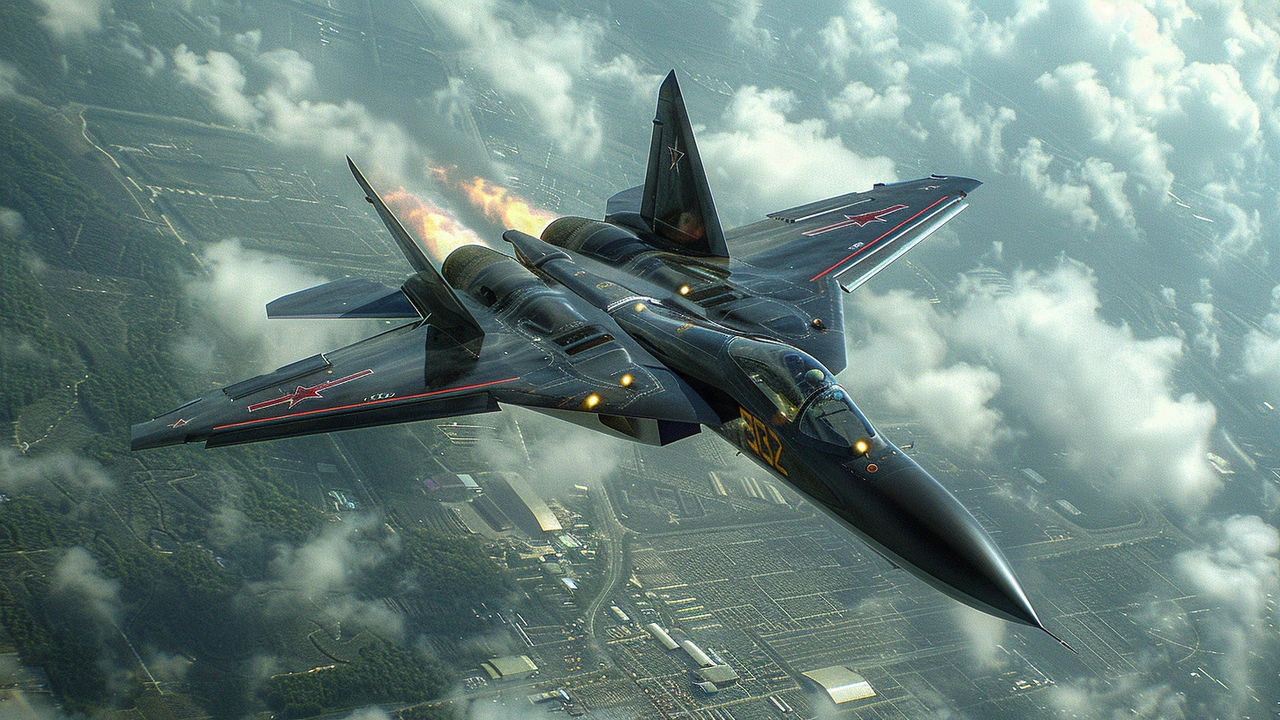China Developing Land-Based Version of FC-31/J-35 Stealth Fighter: Expert Insights

China's Stealth Fighter Evolution: From Carrier to Land-Based Operations
Recent imagery has provided a clear indication that China is advancing work on a land-based iteration of its FC-31/J-35 fighter jet, taking a significant step in enhancing its military aviation capabilities. The FC-31, which originally started as a land-based fighter, found its place in China's carrier operations under the moniker J-35 due to waning early interest in its initial design. With the Shenyang Aircraft Corporation spearheading these developments, there's now a discernible pivot back to its land-based roots.
Analysts have noticed several key alterations in the new land-based variant, dubbed the J-31. Notable design features include a reduction in wing surface area, a noticeable gap between the horizontal tail surfaces and the wings, a single-nose wheel arrangement replacing what would typically be a dual setup in carrier-based aircraft, and the absence of a catapult launch bar. These differences are not mere cosmetic changes but deliberate structural modifications aimed at optimizing the aircraft for land-based operations.
The Journey from FC-31 to J-35 and Back Again
The FC-31 project has seen substantial evolution since its inception. When initial interest faltered, efforts pivoted towards adapting the fighter for naval service, leading to the birth of the J-35 variant. This version underwent myriad changes to meet the demands of aircraft-carrier operations, including modifications for catapult launches and reinforced landing gears for robust takeoffs and landings on carrier decks.
Despite its adaptations, the core design philosophy of the FC-31 remained intact. The fighter jet maintained its stealth features, advanced avionics, and aerodynamic efficiency – attributes that are equally pertinent to land-based operations. Moreover, the iterative design process incorporated feedback from extensive testing and operational data, resulting in a refined aircraft capable of a broad spectrum of operations.
Strategic Implications and Market Potential
The motivations behind China's decision to revisit the land-based FC-31 design remain speculative. However, a few strategic factors stand out. Domestically, a land-based stealth fighter could offer enhanced tactical flexibility and strengthen air defense networks. Internationally, there's a palpable appetite for fifth-generation fighters. Notably, Pakistan has expressed intentions to procure FC-31 jets, a move that could signal broader market penetration for Chinese aircraft manufacturers.
It's also essential to consider the broader geopolitical context. China's burgeoning military-industrial complex is keen on addressing both internal defense requisites and expanding its footprint in the global arms market. By offering a land-based stealth fighter, China can cater to nations without aircraft carrier capabilities but still in need of advanced air combat solutions. This dual approach of maintaining and evolving both land-based and carrier-based variants could ensure sustained interest and versatility in varied operational theatres.
Design and Innovation: Continuous Evolution
The FC-31's development journey underscores China's commitment to continuous innovation in its military aviation sector. The transition from land-based to carrier-based operations and back again reflects a dynamic and adaptive design philosophy. Every iteration has brought with it enhancements that push the envelope of what the aircraft can achieve. Successive prototypes have seen refinements in stealth capabilities, performance parameters, and avionics, underscoring a rigorous and ongoing development process.
One of the standout features in recent prototypes has been the integration of increasingly sophisticated avionics. These enhancements not only augment the fighter's operational efficacy but also signal China's growing prowess in indigenous technology development. From radar-evading stealth technology to advanced electronic warfare systems, the FC-31 encapsulates a holistic approach to modern fighter design.
Looking Ahead: What's Next for the FC-31/J-35
As China continues to test and refine the land-based J-31 variant, several key areas of interest emerge. Operational testing will be critical in determining the efficacy of design changes. Additionally, pilot feedback and combat simulations will provide valuable data, enabling further modifications tailored to real-world scenarios.
There's also a keen global eye on how these developments will translate into export opportunities. Countries seeking fifth-generation fighters are evaluating the FC-31's capabilities and cost-effectiveness against other market offerings. China's ability to position the FC-31 as a competitive option could redefine its role in the global defense market, challenging traditional players and carving out a significant market share.
In conclusion, China's foray into refining and expanding its FC-31/J-35 stealth fighter program is a testament to its strategic foresight and technological ambition. Whether driven by domestic defense needs or international market opportunities, the iterative development of the FC-31 highlights a nuanced and multifaceted approach to modern military aviation. As more data becomes available, the global defense community will undoubtedly keep a watchful eye on the progress and impact of China's dual-variant stealth fighter strategy.






Rob Chapman
June 2, 2024 AT 18:10Interesting shift back to a land‑based version of the FC‑31. It shows China’s flexibility in tech development. The design tweaks like smaller wings and single nose gear make sense for runway ops. This could give their air force more options without the carrier constraints. Overall a solid evolution.
Delaney Lynch
June 2, 2024 AT 19:06Wow, what a fascinating read, and I love how the article breaks down each design change, from the reduced wing area to the single‑nose wheel, with such clarity! The shift back to land‑based operations, indeed, opens a whole new strategic window for China, doesn’t it? It’s also noteworthy how the avionics upgrades could appeal to export markets, especially for nations lacking carriers. I’m excited to see how this will affect global fighter dynamics, and I hope we’ll get more data soon!
Nicholas Mangraviti
June 2, 2024 AT 20:13The J‑31 could fill a niche for many air forces seeking a fifth‑gen platform.
Jared Greenwood
June 2, 2024 AT 21:20China’s push on the J‑31 is a blatant power‑play, a clear signal that they’re racing to outgun NATO allies, and it forces us to accelerate our own fifth‑gen programs or risk strategic inferiority.
Sally Sparrow
June 2, 2024 AT 22:26Honestly, this whole “dual‑variant” marketing gimmick looks like a desperate attempt to peddle sub‑par tech to cash‑strapped clients; the specifications are impressive on paper but the real‑world performance remains dubious at best.
Eric Yee
June 2, 2024 AT 23:33Cool to see Chinese engineers juggling both carrier and runway needs, kinda like a Swiss‑army knife of jet design. The modifications feel practical and it could spice up the market for countries that can’t afford a carrier deck. Props to the teams making it happen.
Sohila Sandher
June 3, 2024 AT 00:40Definately a big step forward for their air force – the J‑31 looks sleek and the stealth tweaks could make it a real contender for nations looking for affordable 5th‑gen tech.
Anthony Morgano
June 3, 2024 AT 01:46Nice article! 😊 The single‑nose gear is a neat tweak – makes maintenance easier. Can’t wait to see those jets in action over the Asian skies. ✈️
Holly B.
June 3, 2024 AT 02:53The strategic implications of China re‑orienting the FC‑31 towards land‑based operations are significant. By offering a versatile platform, they may attract countries lacking carrier capability while strengthening their own air defence posture.
Lauren Markovic
June 3, 2024 AT 04:00The J‑31 represents a compelling synthesis of stealth shaping and modern avionics that rivals many Western designs.
The reduced wing area, while seemingly a trade‑off, actually lowers radar cross‑section and improves roll rate.
The single nose wheel simplifies the landing gear architecture, cutting weight and maintenance cycles.
Internally, the aircraft is equipped with an active electronically scanned array radar that can track multiple targets simultaneously.
Coupled with a modern infrared search and track system, the sensor suite gives pilots situational awareness that rivals the F‑35.
The electronic warfare suite appears to include off‑board jamming pods, making the jet a potent platform for SEAD missions.
From a propulsion standpoint, the WS‑19 engine promises a thrust‑to‑weight ratio that could push the J‑31 to Mach 1.8 in a clean configuration.
This performance envelope opens the possibility of high‑speed interception as well as beyond‑visual‑range engagements.
Export-wise, the price point is likely to be considerably lower than its Western counterparts, which is an attractive proposition for emerging air forces.
Countries like Pakistan have already shown interest, and that could catalyze a regional market shift.
Moreover, the dual‑variant approach allows Shenyang to tailor production lines for both carrier‑compatible and land‑based customers without major re‑tooling.
This flexibility could reduce unit costs and accelerate delivery schedules, a key factor for budget‑constrained militaries.
However, the aircraft’s stealth performance is still unproven in contested environments, especially against low‑frequency radar.
Operational testing will need to validate the aircraft’s maintainability under harsh field conditions, something that many export customers scrutinize closely.
If the J‑31 can demonstrate reliable sortie rates and effective integration with third‑party weapons, it could become a serious contender in the global fighter market.
In short, the J‑31 is a bold step that blends Chinese innovation with practical design choices, and it will be fascinating to watch how it reshapes aerospace competition. 😊
Kathryn Susan Jenifer
June 3, 2024 AT 05:23Oh great, another “miracle jet” that will magically solve every defense budget crisis-because history has shown that never happens.